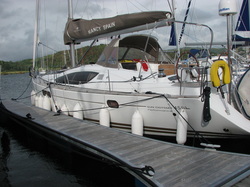
I’m a big fan of a midships spring line for many docking situations, even on fairly small boats. If the bow line is given to a person on the dock first, the bow almost always hits the dock (unless the line handler knows not to pull on it). A midships spring is attached to a strong point at the middle of the boat (a cleat, or a chainplate on a sailboat if there’s no midships cleat). When someone pulls on a midships spring line the middle of the boat moves towards the dock, which is what you want. There are other advantages to using a midships spring line. Check out pp. 142-143 in the Mariner’s Guide for a discussion of docking, and pp. 385-386 for spring lines and techniques used to spring a vessel.
 RSS Feed
RSS Feed